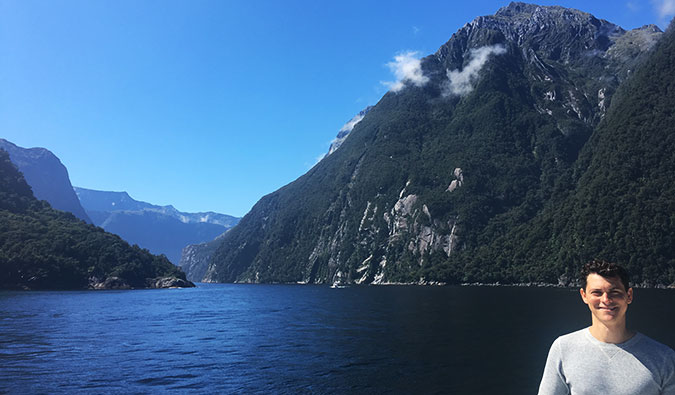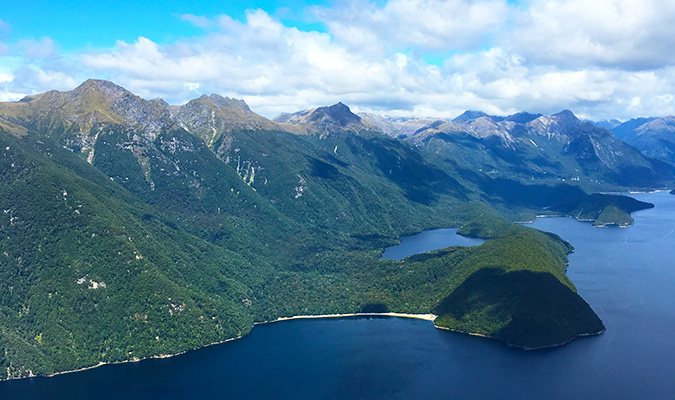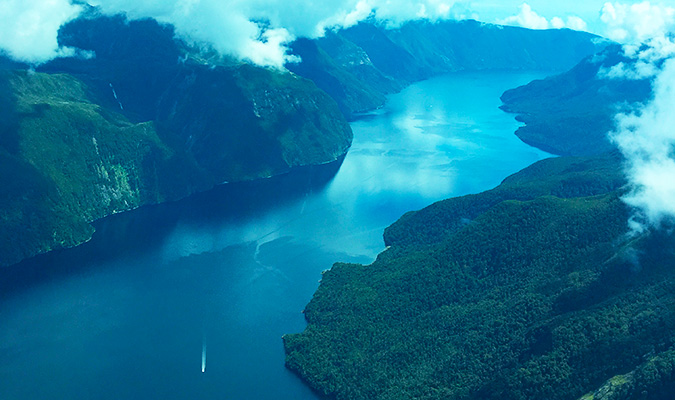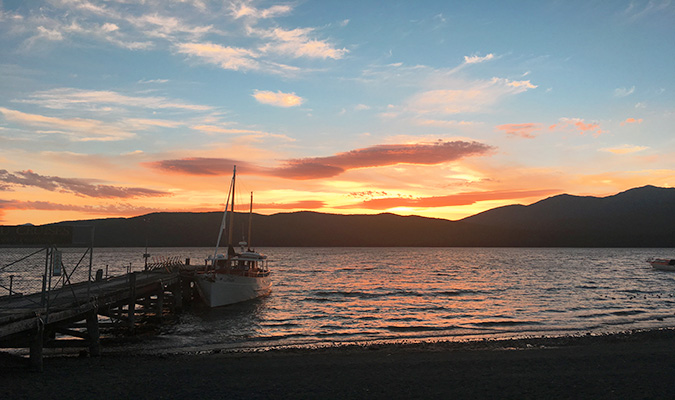Flying High in New Zealand’s Fiordland

“How do you do on boats?”
“I love ’em,” I said gripping the seat of the plane tightly.
“Well, just picture turbulence as waves you can’t see,” the pilot said with a laugh.
“I know turbulence can’t take down a plane, but that doesn’t make this any more comfortable.”
The
plane was jolted as we passed some high mountains. None of the other
passengers seemed to notice, but I cringed with the look of someone who
just got a thousand needles stuck in his arm.
“If something goes wrong here, we just fall and die! That’s just where my mind goes!”
The pilot looked at me, laughed again, and went back to talking to the other passengers.
I
was in a tiny, six-seater seaplane three thousand feet above Doubtful
Sound. Fiordland is located in the southwesternmost part of New Zealand and home to numerous Lord of the Rings
film locations, the region is considered one of the country’s most
scenic and remote areas. Filled with gigantic mountains, deep lakes,
swelling rivers, untamed forests, and resplendent fjords, most of it has
never been set upon by man. Save a few places where boats and planes
can go, the government has made the land off-limits, ensuring that that
will be the case for a long time to come.

The
day before, I had had the bright idea of seeing Doubtful Sound on a
quick one-hour flight instead of a full-day bus/boat ride. Despite my fear of heights and flying, I had thought it would be cool and save me lots of time.
Yet as the teeny plane bounced around, that no longer seemed so bright.
I had hitched a ride to the area with Karin, a Swedish girl I’d met in Wanaka. After a few days partying in Queenstown,
we had driven down to the region’s launching pad, Te Anau, a small town
of barely a few hundred people on a lake, with lots of campervan parks
for tourists who came to camp, hike the Kepler Track and Milford Sound
trail, and visit the area’s two biggest attractions: Milford Sound and
Doubtful Sound.
Karin and I drove up to Milford Sound for the day.
On the way, we passed giant granite mountains, crystal-clear blue
rivers, and roaring waterfalls. Sheer cliffs rose above us as we
followed the road to the sound. Tiny lakes dotted the way, and hiking
trails — some of the country’s “Great Walks” — crisscrossed the area.
This was wild New Zealand, where cellphone service didn’t exist, you had
to camp, and, to quote Doc Brown, “you don’t need roads.” You came here
for one reason: to escape city life.
On our two-hour cruise on
Milford Sound to the edge of the Tasman Sea and back again, water from
the recent rains rushed in a torrent off the sides of the fjord, ice
covered the tops of the mountains, and seals frolicked nearby. It was a
clear, bright, sunny day, the kind that makes you feel like you got the
luckiest card in the traveler’s deck.

The
next day, Karin left but I stayed on. I found an Airbnb run by an older
couple, complete with a garden, sun deck, and hot tub. However, they
had quirky nature, and it was clear that they weren’t that hospitable or
used to young travelers booking via Airbnb. From the odd blackmail (“if
you want to use our kitchen, maybe you can book your tours with me”) to
the reversal of that offer (“I changed my mind”) to the immediate
outpouring of personal information to the shock that someone would cook
in their kitchen to the constant checking up, they left a bad vibe that
made it seem like I never was wanted there.
So I got out of the Airbnb as often as possible. I headed to Wings and Water,
a small seaplane company run by Jim, a hard-nosed pilot who had a lot
to say about the state of modern pilot training and airplane safety. He
spouted off about the nanny state and government regulation not letting
pilots be pilots, companies outsourcing maintenance, the overreliance on
computers and technology, and pilots not going with their guts enough.

“There’s not enough experience out there. A computer isn’t going to save you.”
He had strong opinions on every subject.
“Matt
is afraid of flying, but we’ll make him a man,” he said to the two
other couples waiting to board our flight, slapping my back as he went
to do another safety check on the plane.
I already regretted having mentioned my fear of flying.
With
a sputter of the engine, we coasted on the water and ascended smoothly
into the air. Now, below us, the giant Lake Te Anau and mountains were
splayed out over the landscape. There were lakes leaking down the sides
of mountains, patches of ice dotting inaccessible mountaintops, and
sheer, gray cliffs with trees seemingly hanging on by a root, ready to
slide off at a moment’s notice. We weaved so closely around the
mountains I felt I could touch them.

As the clouds rolled in, I became nervous. With clouds came wind and choppier air.
“How do you know when to turn back? Like is there a point when you go, ‘OK, time to go!’?”
“You just know from experience,” Jim replied.
“What happens if the weather worsens?”
 “Well, you see those big bodies of water down there?”
“Well, you see those big bodies of water down there?”
“Yeah…”
“Well,
we’re in a seaplane. I’d just land the plane on the water and wait it
out,” he replied mater of factly, “But don’t worry. That’s never
happened.”
“Planes,” he continued, “are stronger than people. You’ll break before this baby does.”
We
cut through the clouds and did a loop around the Browne Falls, the
world’s tallest waterslide (since the water technically was always
touching the ground, it wasn’t a waterfall), through which the cascade
poured incessantly from a large pool set in a depression of the
mountain.
As we landed back in Te Anau and pulled up the to dock, Jim looked at me. “Not so bad, huh?”
“No, not so bad, but that didn’t change my view of flying.”
The next day I snuck out of my Airbnb to avoid seeing my hosts and caught the early-morning bus.

As
I watched the sky turn a pink as the sun rose, I was glad that, unlike
my last visit, I didn’t skip this area. Here in this little town on the
edge of New Zealand, where tourists outnumbered locals, there was little
else to do but enjoy nature. The region stripped away the distractions
so common in other parts of the country.



No comments